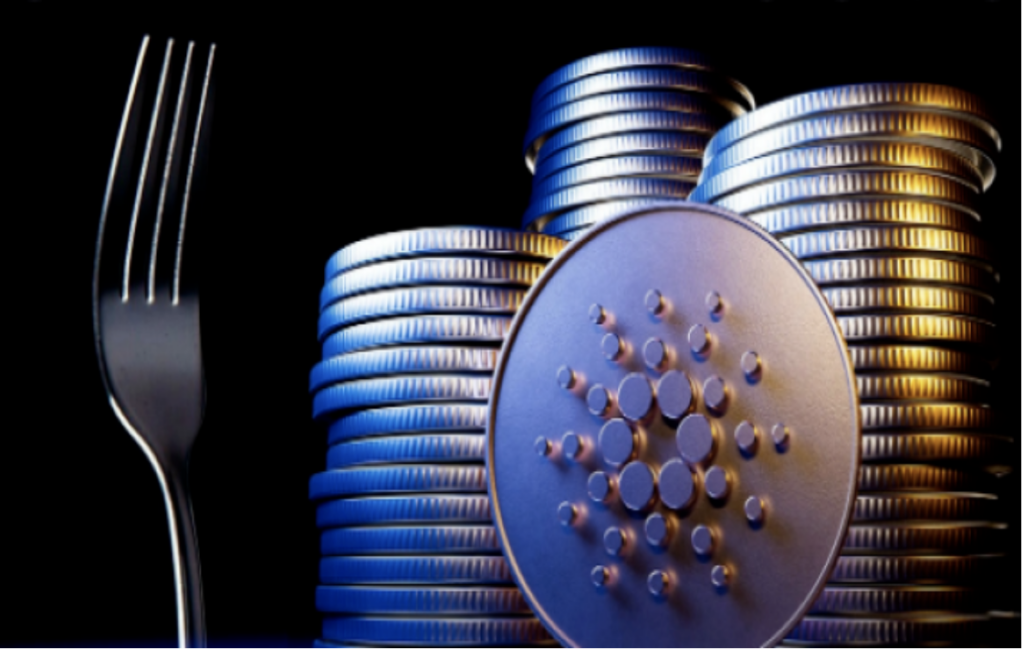Cardano, a peer-reviewed proof-of-stake blockchain with its token known as ADA, had undergone phases of bug fixing and controversy around its proposed update. Being the 8th in the cryptocurrency market capitalization, these flaws have inhibited transaction processes and the realization of a new fork. However, the parent company of ADA, Input Output Hong Kong (IOG), has announced it’s moving closer to the much-anticipated Vasil hard fork. Here’s everything to know about it.
What is a Hard Fork?
A hard fork is a change in the blockchain’s rules that makes it incompatible with the old software. This means all nodes on the network need to update their software if they want to keep using the chain. A hard fork is a significant upgrade, and consequently, it records significant changes to a blockchain network.
The Cardano Hard Fork

The Cardano hard fork is an upgrade planned on the Cardano blockchain network.
The CEO and Founder of Input Output, the company behind the Cardano cryptocurrency network, Charles Hoskinson, on Friday had a live stream in Colorado. In this live stream, he disclosed that the Cardano hard fork, also known as the Vasil hard fork (named after the recently deceased Bulgarian mathematician and propagator of Cardano, Vasil Dabov), is close to happening. He made it clear the upgrade will likely happen in September.
Notably, the Vasil hard fork has once been a subject of controversy. Two influential developers and members of the ADA community, Adam Dean and Andrew Westberg disagreed with Hoskinson on the readiness of version 1.35.3, which stake pool operators were asked to join. However, he publicly addressed the issue, especially Dean’s claim that the process was being rushed. He described the claim as ‘alarmist’ and assured stake pool operators that the code had been thoroughly tested.
Now Hoskinson is prepared to make the upgrade happen soon, though he cited its dependence on crypto exchanges. He said that the next major lift is to get the exchanges on board with them. He also opined that after a hard fork date is announced, it’s normal to see a big rush while people push through.
Last Friday, in a Twitter thread, Input Output, the company backing the Cardano network, shared updates on the status of the Vasil hard fork. These include the announcement that Binance, a popular cryptocurrency exchange platform, is upgrading its Cardano Nodes.
Additionally, version 1.35.3 accounts for 57% of mainnet blocks produced by nodes, which is significantly halfway to reaching the 75% required to launch the upgrade. It should be noted that the metric Cardano needs is 75% of Stake pool operators running node 1.35.3 to launch its upgrade.
The company also disclosed that a configuration was addressed, and the chain density looks perfect. The reason that chain density is essential is that it’s an indicator of how much activity there is on any given blockchain. The more activity there is on a blockchain, the faster it can process transactions. In addition, chain density is also an indicator of how secure the network is. The more users there are mining or transacting on a blockchain, the less likely someone will be able to attack it successfully.
Much Ado About Vasil Hard Fork: Why It Matters
Members of the Cardano blockchain community have anticipated the Vasil hard fork for a long while. Now that its launch is imminent, it’s crucial to disclose what users stand to gain from the upgrade.
If Hoskinson’s plans hatch according to plans, the hard fork will be live in September. The upgrade intends to bring about significant network advancements that will cut transaction sizes, hence increasing network throughput and bringing down transaction prices.
ADA, the Cardano token, is presently priced at $0.4466. Essentially, the Vasil hard fork may encourage ADA uptake because of increased network effectiveness. This can then give the token the confidence to move up in rank. The coin’s supporters are eager for it to get to $1, despite its present fluctuations in the cryptocurrency market.
More Cardano Decentralization: The Icing On The Cake
The upgrade comes with benefits such as low transaction fees and more network efficiency, as well as more decentralization — the icing on the cake. While Cardano is presently decentralized, its network awaits P2P with the Vasil hard fork.
Undoubtedly, good communication between nodes is a necessary requirement for network effectiveness on the blockchain network. For a blockchain to function to its optimal performance, nodes must receive mutual communications without delays.
Presently, Cardano’s networking layer operates on the TCP/IP stack, a set of protocols that allow computers to communicate with each other. It consists of four layers: the physical layer, which defines how the data is transmitted; the link layer, which ensures that information is transferred between computers at different locations on the internet; the Internet layer, which connects various networks; and the transport layer, which provides reliable delivery of data between two hosts.
While the TCP/IP stack promises swift data delivery, it uses a centralized tool called topology updater. A topology updater updates subsets of a distributed system. For instance, in the case of Cardano, the topology updater keeps the nodes live every hour. Users and developers use it for manual or automatic synchronization of data or for updating the status of a particular node.
With the launch of the Vasil hard fork, the Cardano network will adopt a P2P network, operating on decentralized peer-to-peer connections. This means no central authority or server will control or manage the network. This structure also makes P2P networks efficient at distributing information among users because each device can use its resources to pass data to other devices within reach.The P2P network adoption will further enhance the complete decentralization of Cardano’s networking layer. This will consequently foster more adoption of the ADA token and its resilience in the crypto market. This, along with other benefits, is what ADA enthusiasts await with the anticipated Vasil launch next month.
